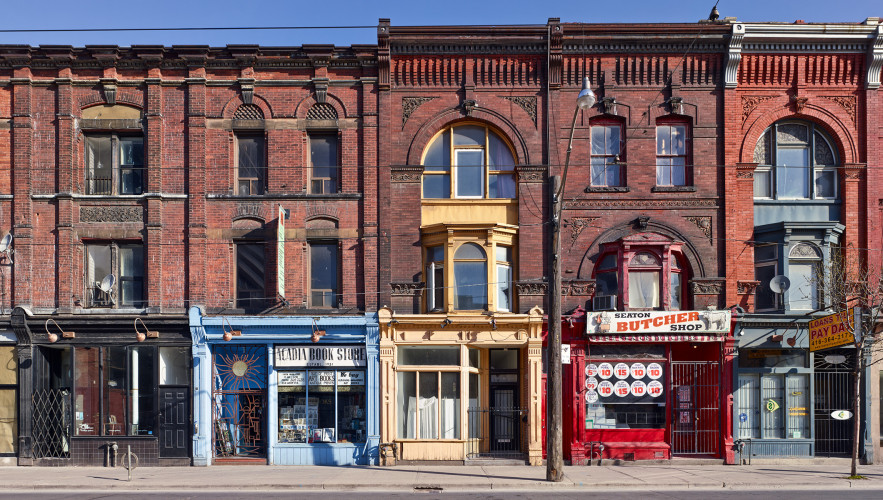David Kaufman’s Early Sunday Morning shows a bygone Toronto
Photographer Kaufman hopes historic brick buildings of Queen St. East and West can be saved
by MARTIN KNELMAN
From The Toronto Star, May 3, 2013
Early Sunday Morning, David Kaufman’s current photo exhibition, is a love letter to Toronto’s historic streetscapes. The stars of the show are three-storey brick buildings that line both Queen St. W. and E., many dating back to the 1880s. Even as downtown Toronto becomes more dominated every year by new condo towers, Kaufman find himself increasingly drawn to these modest historic buildings of a bygone era, which exude warmth, human scale, beautiful masonry and what he calls “the character of age.”
Appropriately, the exhibition — running in conjunction with the Scotiabank CONTACT Photography Festival until May 26 — is taking place at the Twist Gallery at 1100 Queen St. W.
Kaufman, who moved to Toronto from Montreal in 1971, has long had a passion for taking pictures of old buildings and has turned his camera on streets of both cities. But he says Toronto has always had fewer heritage buildings than Montreal and those that we do have enjoyed less protection. Even more problematic, in his view, is that the pace of redevelopment here seems to be constantly accelerating.
The upshot: over the past 20 years or so, many of the industrial buildings Kaufman photographed have disappeared.
“The city I moved to four decades ago barely exists today in many locales,” he says, despairing over the vast swaths of look-alike condo towers.
Besides celebrating smaller, older buildings with more character, which he depicts bathed in sunlight, Kaufman has an agenda: saving both Queen St. W. and E.
Given the radical changes that have occurred on Yonge St., King St., Richmond, Adelaide, Jarvis and even Spadina, Kaufman argues that Toronto is left with Queen St., both east and west, as the only remaining commercial districts that still boast stretches of historic buildings offering a sense of the city’s past.
If you visit the Twist Gallery and see two dozen of Kaufman’s gleaming large-scale images assembled in one large space, you’ll appreciate what he means when he talks about the documentary function of photography.
“Photography enables us to see and fix for all time what is before us with greater clarity and more vividness than what we see with our own eyes,” he claims.
The purpose of his images, Kaufman explains, is to help people remember these places, because he fears that eventually all that will remain of these buildings and streetscapes are these photographs.
And if that happens, he would like to think that his images can help Torontonians remember a distinctive era of the city’s architecture, when its streets featured buildings on a smaller scale created with a kind of craftsmanship that is no longer possible.
Kaufman says his images of buildings near Queen St. east of Sherbourne represent, more than any others, the downtown Toronto of years gone by. Even if these buildings survive, their appearance is likely to change through gentrification, which is what usually happens to old buildings that escape the more drastic fate of demolition.
It would be a great shame, as he says, if Toronto fails to save at least some of these buildings and streetscapes. But there is reason for hope.
If a street is doing well commercially, it is more likely to be preserved and protected. That certainly seems to be the case on Queen West. But Queen East is more vulnerable, because for decades it has been one of the city’s most impoverished areas, the tone set by proximity to the Salvation Army and a mission around the corner..
Kaufman offers a solution.
“Much of Queen St., perhaps from Roncesvalles all the way to Carlaw, should be given a heritage designation and its appearance protected for decades to come.”
But is Toronto City Council likely to make that happen?

Queen Street east of Sherbourne #3, Toronto, April 2012
